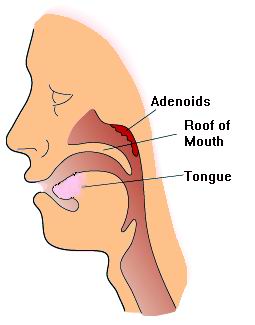
Adenoids are small lumps of tissue in the back of the throat that help fight ear, nose and throat infections in younger children. Adenoids usually reach their maximum size when the child is between three to five-years-old, and then begin to shrink by age seven and can hardly be seen by the lateAdenoidectomy teens.
The adenoids can become infected and swell up in the event of a cold or a throat infection. They can block the nose and make it difficult for your child to breathe, especially when asleep which could lead to sleep problems such as sleep apnea or snoring.
Swollen adenoids can also block the Eustachian tube, which is a tube that connects the back of the throat to the middle part of the ear. Blockage of the eustachian tube can lead to ear infections and a build-up of sticky fluid in the ear - called glue ear. This can make it difficult for your child to hear properly and, as a result, can cause learning problems. Adenoidectomy along with a tube in your child's ear (grommets) is effective in the treatment of glue ear.
Swollen adenoids are often associated with tonsillitis (infected tonsils) and may be removed as part of an operation to remove the tonsils. When both the adenoids and tonsils are taken out the procedure is called an adenotonsillectomy.
Procedure
An adenoidectomy is performed under general anesthesia. The surgeon removes the adenoids from behind the palate. Stitches are usually not required.
Excision through the Mouth
The adenoids are most commonly removed through the mouth after placing an instrument to open the mouth and retract the palate. A mirror is used to see the adenoids behind the nasal cavity. Several instruments can then be used to remove the adenoids.
- Curette removal. The most common method of removal is using the adenoid curette, an instrument that has a sharp edge in a perpendicular position to its long handle. Various sizes of curettes are available.
- Adenoid punch instrument. An adenoid punch is a curved instrument with a chamber that is placed over the adenoids. The chamber has a knife blade sliding-door to section off the adenoids that are then housed in the chamber and removed with the instrument.
- Magill forceps. A Magill forceps is a curved instrument used to remove residual adenoid, usually located deeper in the posterior nasal cavity, after attempted removal with curettes or adenoid punches.
- Electrocautery with suction Bovie. The adenoids can also be removed by electrocautery with suction Bovie, an instrument with a hollow center to suction blood and a rim of metal to achieve coagulation.
- Laser. The Nd:YAG laser has also been used to remove the adenoids. However, this technique has caused scarring of tissue and is usually avoided.
Excision through the Nose
Adenoids may also be removed through the nasal cavity with a surgical suction instrument called a microdebrider. With this procedure, bleeding is controlled either with packing or suction cautery.
The operation is always done under general anesthesia and normally takes about 30 minutes. Children may complain of a sore throat, and pain in their nose and ears, a small nose bleed is also common after surgery.
The other ENT Procedures are:
Few Popular Hospitals for Adenoidectomy are:
Thailand, Malaysia, Singapore, Turkey and India are the most cost effective locations that offer up to almost 80% savings in comparison to the US.
SurgeryPlanet facilitates a plethora of services to the medical treatment traveler also which includes, a hassle free and discounted travel option, a welcome hand at the airport on arrival, travel in an air-conditioned car, round the clock service & support. Your medical evaluation is pre arranged with the least of waiting time. Once your assessment is complete and found medically fit, the procedure is immediately scheduled without a waiting period. Please read through our Services and Testimonials to understand and select your best options.
Hospitals For Ethmoidectomy | Doctors For Ethmoidectomy | Cost For Ethmoidectomy | Treatment For Ethmoidectomy | Destinations For Ethmoidectomy | Risks Ethmoidectomy | Ethmoidectomy In India | Ethmoidectomy Recovery | Ethmoidectomy Information | Ethmoidectomy Thailand | Ethmoidectomy In Malaysia | Ethmoidectomy Abroad | Ethmoidectomy Overseas | Ethmoidectomy Low Cost | Ethmoid Sinuses | Ethmoid Sinus Cells | Sinus Problems | Ethmoidectomy in Singapore | Ethmoidectomy in Argentina | Surgery Ethmoidectomy | Ethmoidectomy in Singapore General Hospital | Ethmoidectomy in Apollo Hospitals
SurgeryPlanet is an Healthcare Facilitator and not a Medical service provider. The information provided in this website is not to be used for diagnosis or treatment of any medical condition or use for any medical purposes. We provide information solely for medical travel facilitation and do not endorse any particular health care provider, hospital, facility, destination or any healthcare service or treatment listed. We are not an agent for, or affiliated to any health care provider, or service listed in our website and is not responsible for health care services provided by them. Choice of hospital or doctor for your healthcare services is your independent decision. Consult your domestic licensed health care provider before seeking the services of any health care provider you learn about from our website.


